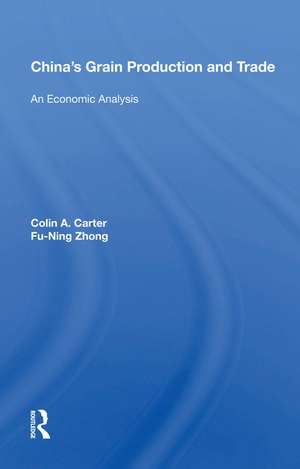China's Grain Production And Trade: An Economic Analysis
Autor Colin A. Carteren Limba Engleză Hardback – 23 mai 2019
Preț: 763.48 lei
Preț vechi: 1102.36 lei
-31% Nou
Puncte Express: 1145
Preț estimativ în valută:
146.14€ • 158.79$ • 122.84£
146.14€ • 158.79$ • 122.84£
Carte tipărită la comandă
Livrare economică 21 aprilie-05 mai
Preluare comenzi: 021 569.72.76
Specificații
ISBN-13: 9780367014384
ISBN-10: 0367014386
Pagini: 138
Dimensiuni: 146 x 229 mm
Greutate: 0.41 kg
Ediția:1
Editura: Taylor & Francis
Colecția Routledge
Locul publicării:Oxford, United Kingdom
ISBN-10: 0367014386
Pagini: 138
Dimensiuni: 146 x 229 mm
Greutate: 0.41 kg
Ediția:1
Editura: Taylor & Francis
Colecția Routledge
Locul publicării:Oxford, United Kingdom
Cuprins
Preface -- An Overview of China's Grain Production and Trade -- China's Grain Policies and Their Impact on Production -- The Internal Grain Marketing System -- Production Models -- Consumption Models -- Projections and Trade Implications
Descriere
China, with over 20 percent of the earth's population, is both the world's largest producer and largest consumer of cereal grains. As a consequence, the supply and demand of grain in China will have a major impact on the world food trade. In this comprehensive study of China's grain production and trade, Colin A. Carter and Fu-Ning Zhong trace the historical role of China in the grain trade; analyze the impact of economic and political variables on production, consumption, and trade; and discuss alternative scenarios for China's future levels of trade. This is the first study to move beyond aggregate data to deal with regional models of Chinese grain production. The authors' major findings are that budgetary pressures will limit further increases in grain prices, and consequently the growth rate in grain yields will slow. As the total population continues to increase, China's area planted in grain will decline. The Chinese will gradually shift their food consumption toward more meat and other indirect grain consumption; therefore China may continue to import a limited amount of grain but imports will shift from wheat to feed grains.
